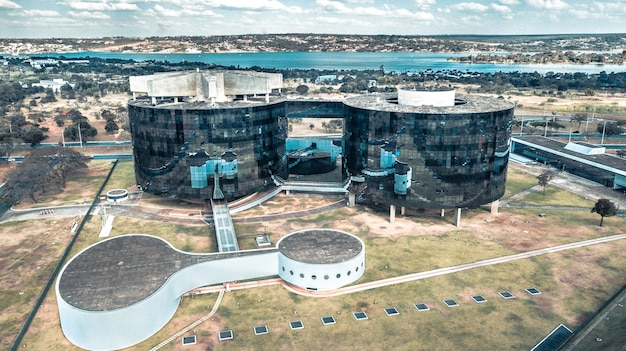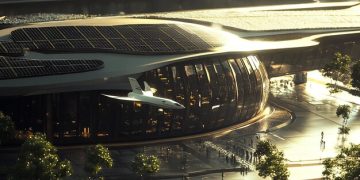SMRs: Can Small Nuclear Reactors Solve US Energy Needs by 2027?

Small Modular Reactors (SMRs) could offer a promising solution to the United States’ increasing energy demands, but questions remain about their feasibility, cost-effectiveness, and regulatory approval timelines for widespread deployment by 2027.
The United States is facing mounting pressure to modernize its energy infrastructure while simultaneously reducing its carbon footprint. The development and deployment of small modular reactors (SMRs) a Viable Solution for US Energy Needs by 2027? is a frequent question in that pursuit, offering the promise of cleaner, more efficient nuclear power.
Understanding Small Modular Reactors (SMRs)
Small Modular Reactors represent a significant departure from traditional nuclear power plants. They are designed to be smaller, more flexible, and potentially more cost-effective in their deployment.
SMRs are nuclear fission reactors that are much smaller than conventional reactors, typically generating less than 300 MW of electricity. Their modular design allows for factory fabrication and easier on-site assembly.
Key Characteristics of SMRs
SMRs offer several advantages compared to traditional nuclear plants. Their smaller size reduces capital costs and construction time. The modular design enables scalability, allowing utilities to match capacity with demand. SMRs also incorporate enhanced safety features, such as passive cooling systems.
SMR Technology Types
There are several different SMR technologies being developed, including:
- Pressurized Water Reactors (PWRs): These are the most mature SMR technology, based on existing PWR designs.
- Boiling Water Reactors (BWRs): Similar to PWRs, but use a different method for generating steam.
- High-Temperature Gas-Cooled Reactors (HTGRs): These reactors use helium as a coolant, which allows for higher operating temperatures and improved efficiency.
- Fast Neutron Reactors (FNRs): These reactors use fast neutrons to fission fuel, which can potentially breed more fuel and reduce nuclear waste.

SMRs represent a promising advancement in nuclear technology. They offer a more flexible and scalable approach to nuclear power generation, with the potential to reduce costs and improve safety.
The Potential Role of SMRs in Meeting US Energy Needs
As the United States seeks to transition to a cleaner energy future, SMRs could play a critical role in meeting the nation’s growing electricity demands.
Nuclear energy currently provides about 20% of the electricity in the United States. SMRs have the potential to increase this percentage, providing a reliable and carbon-free source of baseload power.
Addressing Climate Change
SMRs do not produce greenhouse gas emissions during operation, making them a valuable tool in combating climate change. By replacing fossil fuel-based power plants with SMRs, the United States can significantly reduce its carbon footprint.
Enhancing Energy Security
SMRs can enhance energy security by diversifying the nation’s energy mix and reducing reliance on foreign sources of fuel. Nuclear fuel is relatively abundant and can be stockpiled for extended periods, insulating the United States from global energy market volatility.
Supporting Grid Modernization
SMRs can contribute to grid modernization by providing flexible and dispatchable power. Their smaller size allows them to be located closer to demand centers, reducing transmission losses and improving grid stability.
SMRs have the potential to provide a significant contribution to the United States’ future energy needs. Their carbon-free electricity generation, enhanced energy security, and support for grid modernization make them an attractive option for a sustainable energy future.
Challenges to SMR Deployment by 2027
Despite the potential benefits of SMRs, there are several challenges that need to be addressed to ensure their widespread deployment by 2027.
These challenges include regulatory hurdles, high capital costs, and public acceptance. Overcoming these obstacles is necessary for SMRs to become a viable part of the US energy mix.
Regulatory Approval Process
The Nuclear Regulatory Commission (NRC) is responsible for licensing and regulating nuclear power plants in the United States. The regulatory approval process for new nuclear technologies can be lengthy and expensive. Streamlining this process is crucial for accelerating SMR deployment.
Economic Viability
The high capital costs associated with building new nuclear power plants have been a major barrier to their deployment. SMRs have the potential to reduce these costs through their modular design and factory fabrication. However, it is essential to demonstrate the economic viability of SMRs to attract investment.
- Cost Overruns: Past nuclear projects have struggled with cost overruns, impacting investor confidence.
- Supply Chain: Establishing a robust supply chain for SMR components is critical.
- Financing: Securing adequate financing for SMR projects is essential for their success.
Overcoming these challenges is crucial for the successful deployment of SMRs by 2027. Streamlining regulations, reducing costs, and increasing public acceptance are essential for unlocking the potential of SMRs to contribute to a cleaner and more secure energy future.

Global Competition in SMR Development
The United States is not alone in pursuing SMR technology. Several countries around the world are actively developing and deploying SMRs.
Countries like Russia, China, and the United Kingdom are investing heavily in SMRs, posing a competitive landscape for the United States.
Russia’s SMR Program
Russia has been a leader in SMR development, with its floating nuclear power plant, the Akademik Lomonosov, already in operation. Russia is also developing land-based SMRs for remote regions.
China’s SMR Ambitions
China has ambitious plans for SMR deployment, aiming to build multiple SMRs in the coming years. China’s rapid economic growth and increasing energy demand are driving its interest in SMR technology.
United Kingdom’s SMR Strategy
The United Kingdom is also pursuing SMR technology as part of its strategy for decarbonizing its economy. The UK government is providing funding for SMR development and deployment.
The rise of SMR technology presents both opportunities and challenges for the United States. By investing in SMR development and deployment, the United States can maintain its leadership in nuclear technology and ensure its energy security in a rapidly changing global landscape.
Public Perception and Acceptance of SMRs
Public perception plays a crucial role in the success of any energy technology, including SMRs.
Addressing public concerns about nuclear safety is essential for gaining acceptance of SMRs. Transparency and open communication with the public are crucial elements for successful deployment.
Addressing Safety Concerns
Nuclear safety is a primary concern for the public when it comes to nuclear power. SMRs incorporate enhanced safety features, such as passive cooling systems, which can help to address these concerns.
Community Engagement
Engaging with local communities is essential for building trust and addressing concerns about SMR deployment. Providing information about the benefits of SMRs and addressing any potential risks can help to foster public acceptance.
Positive public perception is essential for the successful deployment of SMRs. By addressing safety concerns, and promoting transparency, the nuclear industry can gain public support for this promising technology.
Policy and Investment Landscape for SMRs in the US
Government policies and investment play a critical role in fostering the development and deployment of new energy technologies.
The US government has been supporting SMR development through funding for research, development, and demonstration projects. Supportive policies are crucial for accelerating SMR deployment.
Government Funding and Incentives
The Department of Energy (DOE) has provided funding for SMR projects through various programs, such as the Advanced Reactor Demonstration Program (ARDP). These programs provide financial assistance for the development and demonstration of SMR technologies.
Regulatory Support
The Nuclear Regulatory Commission (NRC) is working to streamline the regulatory approval process for SMRs. This includes developing new regulatory frameworks that are tailored to the unique characteristics of SMRs.
- Tax Credits: Providing tax credits for SMR deployment can incentivize investment.
- Loan Guarantees: Offering loan guarantees can reduce the financial risk of SMR projects.
- Public-Private Partnerships: Encouraging collaboration between the government and private sector can accelerate SMR deployment.
Government policies and investment are essential for creating a favorable environment for SMR deployment. Supportive policies, streamlined regulations, and financial incentives can help to unlock the potential of SMRs to contribute to a cleaner and more secure energy future for the United States.
| Key Point | Brief Description |
|---|---|
| 💡 SMRs Potential | Offer flexible, scalable, and cleaner nuclear energy. |
| 🌍 Global Competition | Russia and China are leaders, pushing innovation and deployment. |
| 🛡️ Public Acceptance | Crucial; requires transparency and addressing safety concerns. |
| 🏛️ Policy & Investment | Government support is vital for development and implementation. |
FAQ
▼
SMRs are compact nuclear fission reactors that generate less than 300 MW of electricity. Factory-built and easily assembled on-site, offering scalability and enhanced safety features compared to traditional reactors.
▼
SMRs produce no greenhouse gasses during power generation. Replacing fossil fuel plants with SMRs drastically reduces your carbon footprint, aiding climate change mitigation efforts.
▼
Facing regulatory hurdles, economic viability, and public acceptance concerns delays. Regulatory approval processes must be streamlined, costs reduced, and trust built through transparency.
▼
Russia and China are investing heavily in the SMR sector. The US must compete globally by fostering SMR innovation through sustained incentives and infrastructure programs.
▼
Department of Energy (DOE) Advanced Reactor Demonstration Program (ARDP) supports SMR projects. The NRC aims to streamline approvals to boost the practical application of SMR technologies across sectors.
Conclusion
In conclusion, while small modular reactors (SMRs) a Viable Solution for US Energy Needs by 2027? holds considerable promise as a cleaner and more efficient energy solution for the United States, several challenges must be addressed to ensure their viability by 2027. Streamlining regulatory processes, reducing costs, addressing public concerns, and maintaining a competitive edge in the global market are essential steps for successfully deploying SMRs and realizing their potential to contribute to a sustainable energy future.




